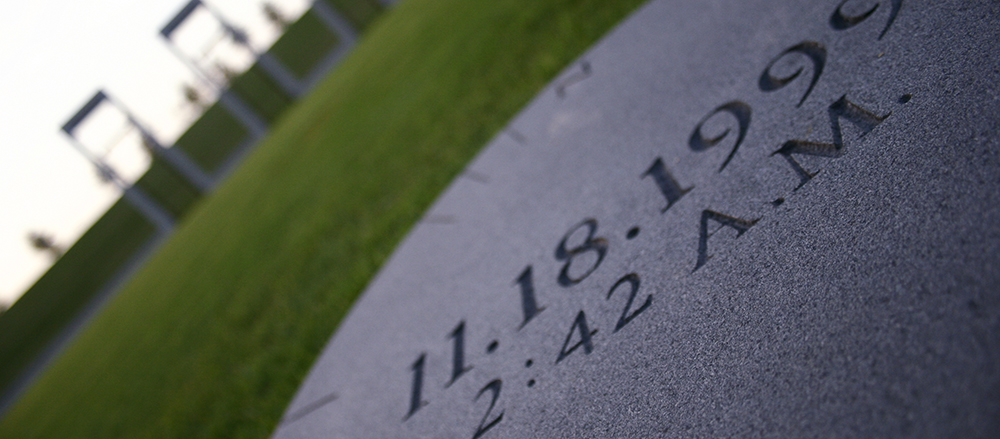Bonfire Memorial honors Aggies lost, injured 20 years ago
It’s been 20 years since the collapse of Bonfire, the Nov. 18, 1999 tragedy that took the lives of 12 Aggies and injured 27 others.
Five years later, the [Bonfire Memorial] (https://bonfire.tamu.edu) , which celebrates the tradition, history, spirit of Texas A&M and the dedication of those involved in Bonfire’s tragic collapse, was dedicated.
The memorial’s design, comprised of three main elements — Tradition Plaza, History Walk and Spirit Ring — was created by a team of architects led by [Robert Shemwell '82] (https://www.overlandpartners.com/people/robert-l-shemwell/) , a principal with Overland Partners, a San Antonio design firm.
He said the structure’s design and construction was more than just the creation of an object — it was the creation of a shared experience.
“This is one of the very unique things about the memorial — it requires active participation. You inhabit it. It doesn't become complete without you there,” said Shemwell at a program in Rudder Auditorium the night before the memorial’s Nov. 18, 2004 dedication.
Shemwell, an [Outstanding Alumnus] (https://www.arch.tamu.edu/community/formerstudents/outstanding-alumni/past-honorees/72/) of the College of Architecture, said the project had three design objectives: commemoration of the tragedy, celebration of unity and reflection of Bonfire history. He added that the memorial could not have reached its full potential without the participation of the families of the lost Aggies. The families’ input, he said, was the key to putting a lot of power and authority in the design.
Selected from nearly 200 entries in a year-long international competition coordinated by faculty in the college’s [Department of Landscape Architecture and Urban Planning] (http://laup.arch.tamu.edu) , Shemwell’s design was the unanimous choice of a jury whose members included leading design professionals, family representatives and Texas A&M student, faculty and alumni representatives.
The memorial was included alongside the Lincoln Memorial and Vietnam Veterans Memorial as one of America’s 37 most beloved national landmarks in “ [Monuments—America’s History in Art and Memory] (https://archcomm.arch.tamu.edu/archive/news/spring2008/stories/bonfireMemorial.html) ,” a 2007 book by bestselling author and architectural historian Judith Dupré.
“There is a palpable, physical sensation of having left ordinary time and entered an eternal dimension,” said Dupré of entering the memorial’s centerpiece, the granite Spirit Ring, which was built where Bonfire once burned.
She compares the Ring, which features 12 16-foot tall gateways, one to commemorate each of the 12 Aggies killed in the tragedy, to Stonehenge and other ancient ceremonial circles.
“Whether old or new,” she writes, “such stones consecrate a cyclical ordering of time as it has always been marked, and affirm that the present moment, along with what once was and will be, is part of the sacred continuum.”
Dupré also wrote about the technical challenges faced during the memorial’s construction. One hurdle was created by the Spirit Ring’s stone portals, which could not be set in the site’s damp soil due to their immense weight; a suspended foundation system was devised to absorb the movement of the portals.
An underground drainage system was devised to handle College Station’s almost 40-inches a year rainfall total.
“Every tool of art, architecture, and landscape was used to mitigate various site challenges, including an adjacent parking lot for several thousand cars that was visually jarring,” she said.
She was especially impressed by a berm, which she termed “a cradling mound of earth” that was constructed to block the view of the lot and situate the memorial.
Richard Nira
rnira@arch.tamu.edu
Tags
Related Posts

Cisneros ’68 helped college celebrate 50th anniversary

Archaeologists headlined CHC symposium in March

CHC study reveals decay on Alamo’s iconic west facade

Architecture prof's designs festoon Hispanic gala

Oct. 23 symposium spotlighted college, faculty research
Follow Us
Facebook Twitter Vimeo Youtube Flickr RSS
Recent Posts

Planning prof heads study of disaster housing aid

A message from the dean

Former student remembered as expert planner

Leading educator named new head of Architecture Dept.





_thumbnail_small.png)
